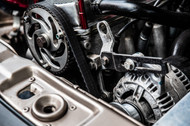Serpentine Belts vs Timing Belts: What's the Difference?
21st Oct 2021
When looking inside your vehicle's engine bay, you may discover several belts. Most vehicles have a timing belt as well as one or more serpentine belts. While they both consist of looped pieces of material, serpentine belts and timing belts aren't the same. They serve completely different purposes that
What Is a Serpentine Belt?
A serpentine belt is a long and looped piece of material -- they are typically made of a rubber or a similar polymer-based material -- that's used to activate motor-driven parts or systems in a vehicle. While your vehicle's engine, the serpentine belts will spin. This spinning action will then activate the parts and systems to which they are connected.
Serpentine belts are oftentimes used to activate and power the following the parts:
- Air conditioner
- Coolant pump
- Steering fluid pump
- Alternator
What Is a Timing Belt?
A timing belt, on the other hand, is a shorter piece of looped material that's used specifically to synchronize the camshaft with the crankshaft. The timing between these two components is important for all combustion engines. When timed correctly, the pistons and valves will operate in harmony with each other.
You can find the timing belt connected to the camshaft and crankshaft. As the engine runs, these parts will open and close in harmony with each other thanks to the timing belt. The timing belt lives up to its namesake by regulating the "timing" of the camshaft and crankshaft.
Differences Between Serpentine Belts and Timing Belts
As previously mentioned, serpentine belts and timing belts are used for different purposes. Serpentine belts are designed to activate motor-driven parts and systems, whereas timing belts are used to synchronize the camshaft with the crankshaft.
Another difference between serpentine belts and timing belts involves the material from which they are made. Serpentine belts are typically made of a rubber or a polymer-based material. They are soft and somewhat elastic. Timing belts are still made of rubber as well, but they are reinforced with fiberglass. With their fiberglass-reinforced construction, timing belts are inherently stronger than serpentine belts.
While all vehicles have one or more serpentine belts, they may or may not have a timing belt. Some vehicles have a timing chain instead of a timing belt. Timing chains serve the same purpose of synchronizing the camshaft with the crankshaft. They are simply constructed of metal links rather than a solid and looped piece of material.
Here is a short list of tools you may need to purchase to replace a timing belt:
- Sockets
- Torque Wrench
- Wrench Set
- Screwdrivers
- Hydraulic Jack
- Jack Stands

